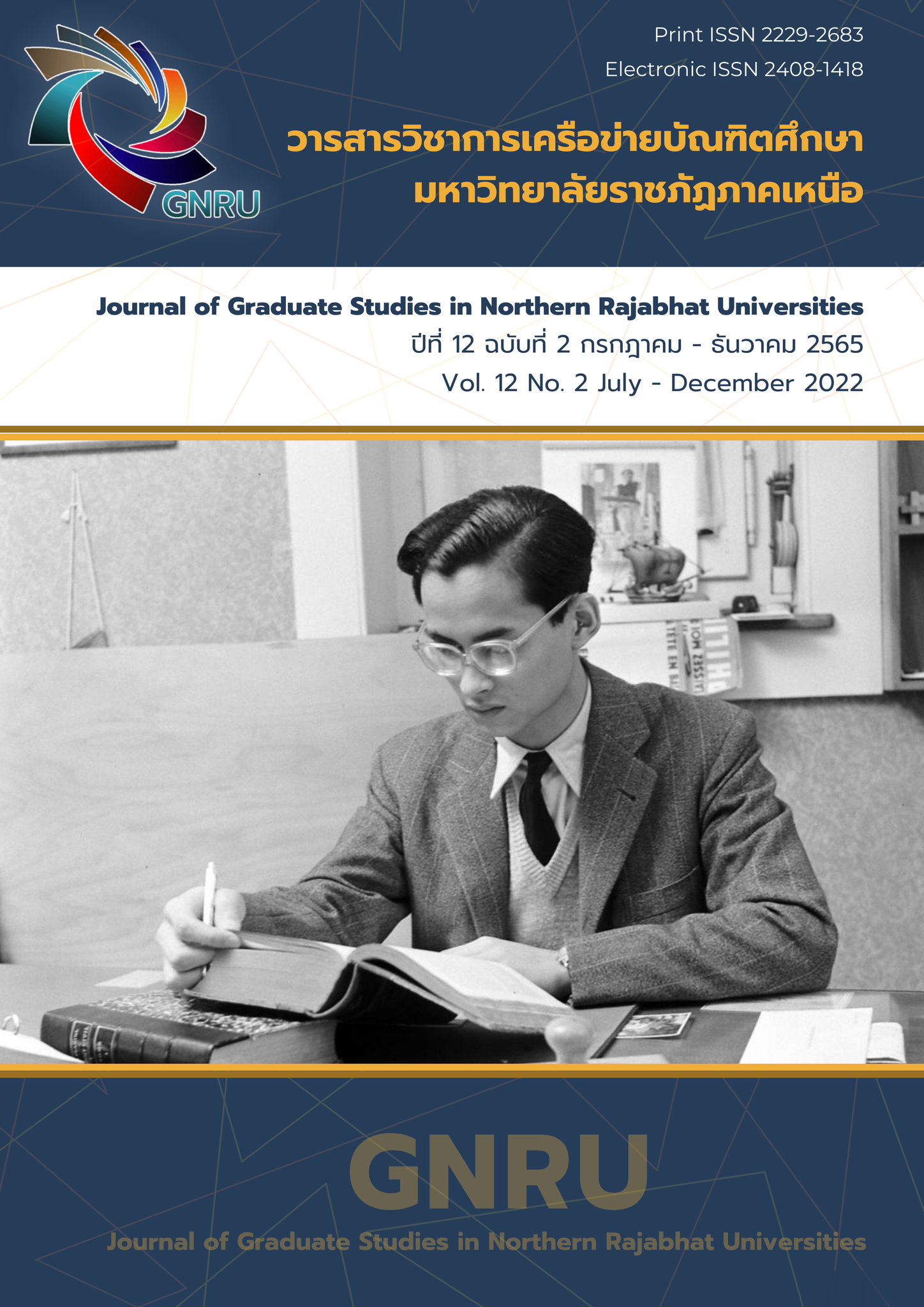KNOWLEDGE AND CREATION OF PHLENGRUA BY THE PARTICIPATION OF COMMUNITY, TAMBON THA-PHO, MUEANG PHITSANULOK DISTRICT, PHITSANULOK PROVINCE
Main Article Content
Abstract
The purposes of this research study were to investigate knowledge and cultures of boating songs plays through the Tha-pho Elderly Community, Muang District, Phitsanulok and create phlengrua with the Community. The participants were categorized into 2 groups including 1) information provider group, who were professional in folk plays, community philosopher, and those volunteering elderlies within the community; and 2) the sample group, that included 8 volunteering elderlies from Tha-pho Community. The eight participants in the sample group were the registered population of Tha-pho Sub-district, Muang District, Phitsanulok Province. The group would collaborate in creating phlengrua in the study. The study tools were experienced-based interview and creative-work evaluation. The results of the study revealed in 2 aspects as follows. Firstly, Phlengrua by Tha-pho Community, Phitsanulok, were remarkable with the language in which applied the local dialect to the lyrics, so the songs were the identity of Tha-pho Community. However, Phlengrua have been gradually disappeared according to the world changes. The next finding was about the songs in which were brainstormed among the community members. They created and performed together; and it was measured at the Excellent Level. This also enhanced the community members to live in harmony and be aware of the local culture values through the local plays in order to make the most benefits for the community and society. This could be considered as the method to make awareness to the youth on the values of local culture and wisdoms. As a result, it could be further preserved and transferred to the next generations.
Article Details
References
ฉวีวรรณ สุวรรณาภา, อภิชา สุขจีน, พัฒน์นรี อัฐวงศ์ และวราภรณ์ ดวงแสง. (2564). การสร้างสรรค์ผลงานศิลปะนำไปสู่การยกระดับรายได้สู่เศรษฐกิจชุมชน ในกลุ่มจังหวัดล้านนา. วารสารมหาจุฬานาครทรรศน์, 8(2), 185-197.
ชาย โพธิสิตา. (2550). ศาสตร์และศิลป์แห่งการวิจัยเชิงคุณภาพ. (พิมพ์ครั้งที่ 3). กรุงเทพฯ: อมรินทร์ พริ้นติ้งแอนด์ พับลิชชิ่ง จำกัด (มหาชน).
ซาฮีฎีน นิติภาค, กามีลียา หะยีหะซา, ฟีรดาวซ์ มูหะมัด, รอฮานี เต๊ะซา และสุไลมาน สมาแฮ. (2561). การอนุรักษ์ศิลปวัฒนธรรมการละเล่นกรือโต๊ะ อำเภอแว้ง จังหวัดนราธิวาส. วารสารมหาวิทยาลัยนราธิวาสราชนครินทร์ สาขามนุษยศาสตร์และสังคมศาสตร์, 5(3), 97-106.
บัวผัน สุพรรณยศ. (2562). เพลงพื้นบ้านภาคกลาง. วารสารมนุษยศาสตร์วิชาการ, 26(2), 152-200.
วิชญ์ บุญรอด. (2565). นวัตกรรมเครื่องดนตรีสำหรับผู้สูงอายุประเภทเครื่องดีดและเครื่องตี เพื่อใช้ในกิจกรรมดนตรีผู้สูงอายุ ตำบลท่าโพธิ์ อำเภอเมือง จังหวัดพิษณุโลก. วารสารมนุษยศาสตร์ มหาวิทยาลัยนเรศวร, 19(1), 132-153.
ศันสนีย์ ฉัตรคุปต์. (2545). “ท่านกำลังทำร้าย (ฆ่า) ลูกศิษย์โดยไม่รู้ตัวหรือไม่,” วารสารมิตรครู, 3(2), 24-25.
สุนันทา เกตุเหล็ก. (2561). การสร้างสรรค์งานนาฏศิลป์ไทยเชิงอนุรักษ์: ฉุยฉายธนบุรี. วารสารคณะศิลปกรรมศาสตร์ จุฬาลงกรณ์มหาวิทยาลัย, 5(1), 69-77.
อารมณ์ สุวรรณ์ปาล. (2547). “การเล่นกับการสร้างเสริมประสบการณชีวิตเด็กปฐมวัยเด็กปฐมวัย”, ในเอกสารการสอนชุดวิชาการสร้างเสริมประสบการณ์ชีวิต ระดับปฐมวัย หน่วยที่ 8-15.
(พิมพ์ครั้งที่ 8). หน้า 9-12. นนทบุรี: มหาวิทยาลัยสุโขทัยธรรมาธิราช.
Edward, K. L., and Welch, T. (2011). The extension of Colaizzi’s method of phenomenological enquiry. Contemporary Nurse, 39(2), 163–171.
Thompson G. A. (2018). Long-Term Perspectives of Family Quality of Life Following Music Therapy with Young Children on the Autism Spectrum: A Phenomenological Study. Journal of music therapy, 54(4), 432–459.
Wang, S., and Agius, M. (2018). The use of Music Therapy in the treatment of Mental Illness and
the enhancement of Societal Wellbeing. Psychiatria Danubina, 30(Suppl 7),595–600.
Wesseldijk, L. W., Ullen, F., and Mosing, M. A. (2019). The Effects of Playing Music on Mental
Health Outcomes. Scientific reports, 9(1), 12606.
Wetherick D. (2009). Music in the family: Music Making and Music Therapy with Young Children
and Their Families. The Journal of Family Health Care, 19(2), 56–58.


